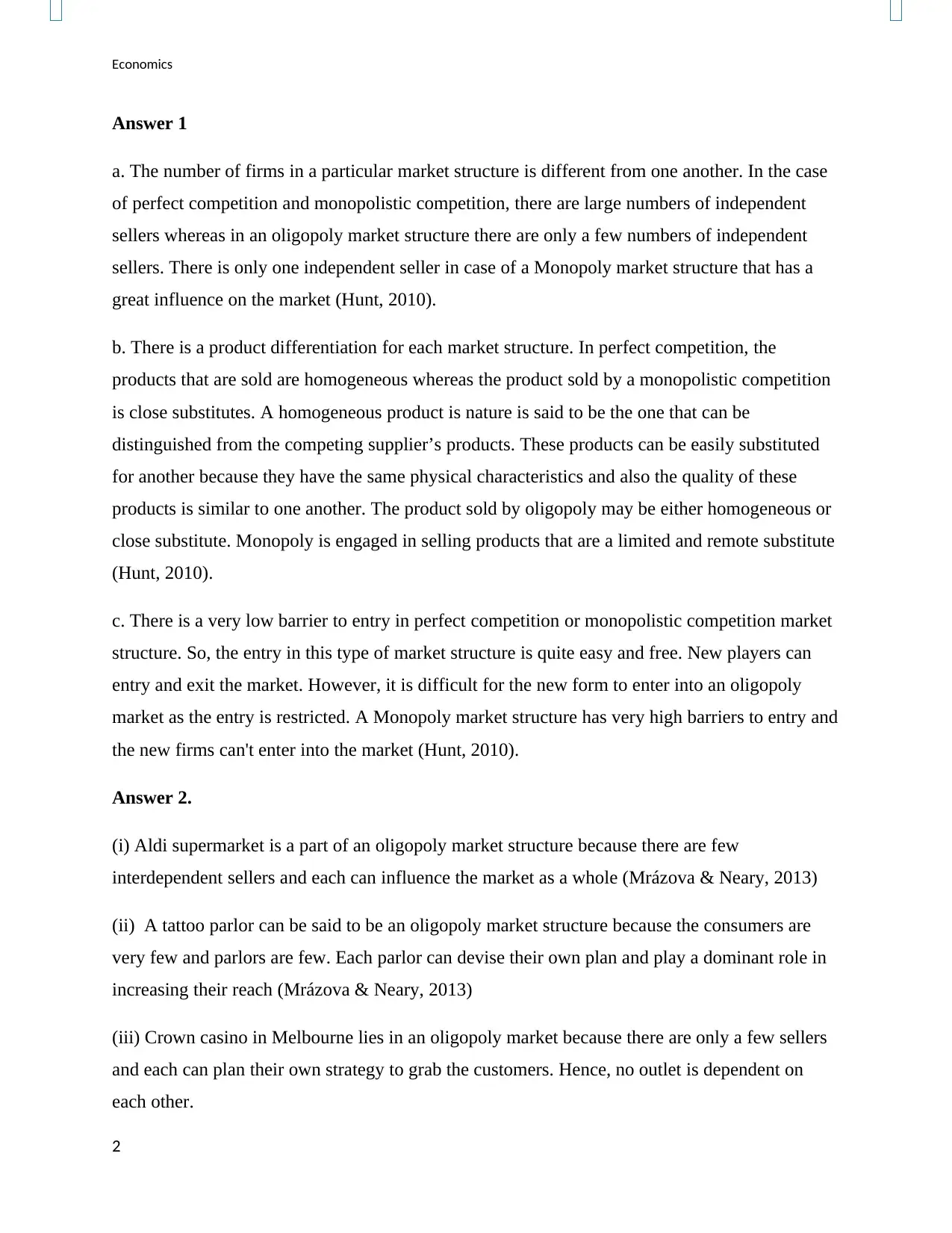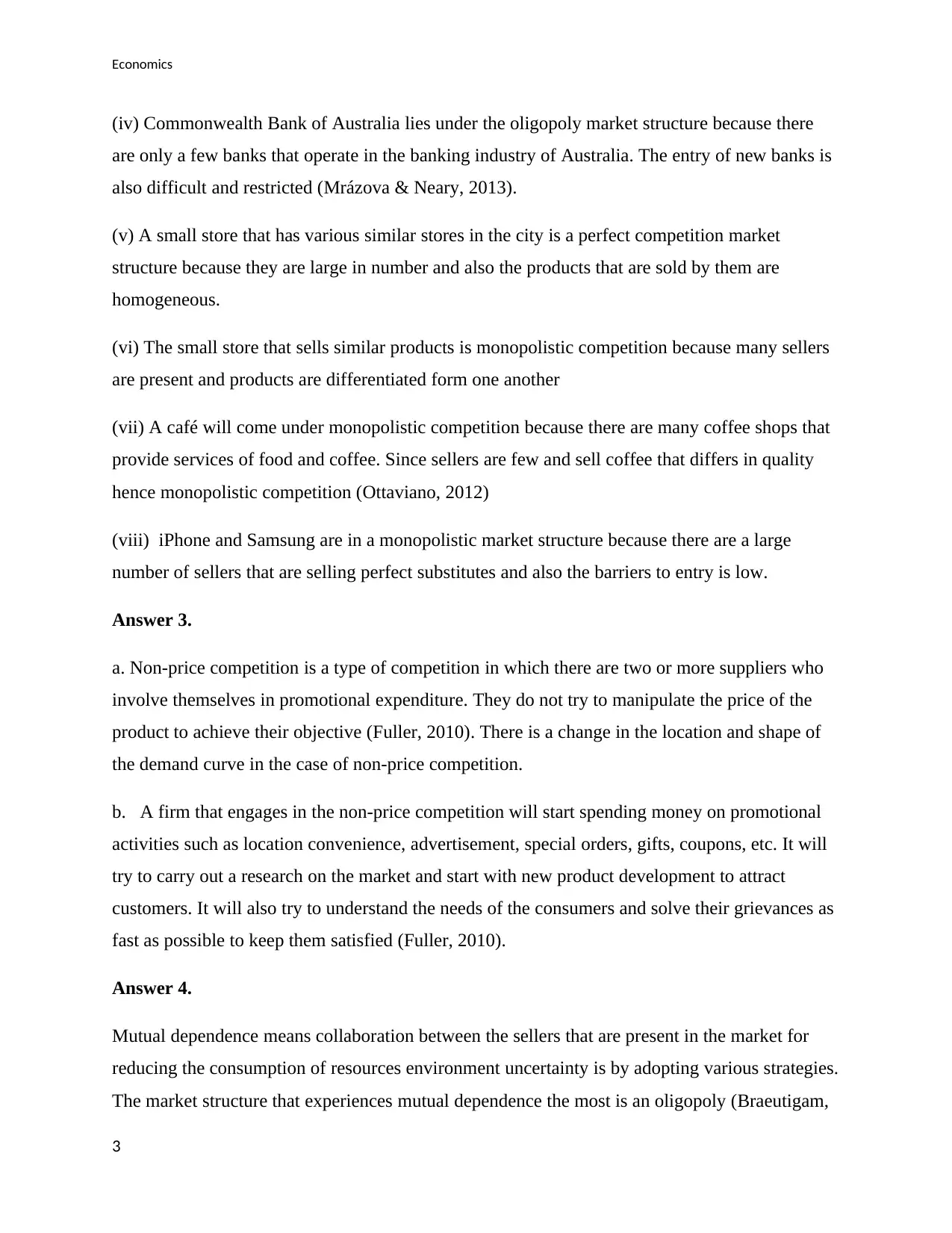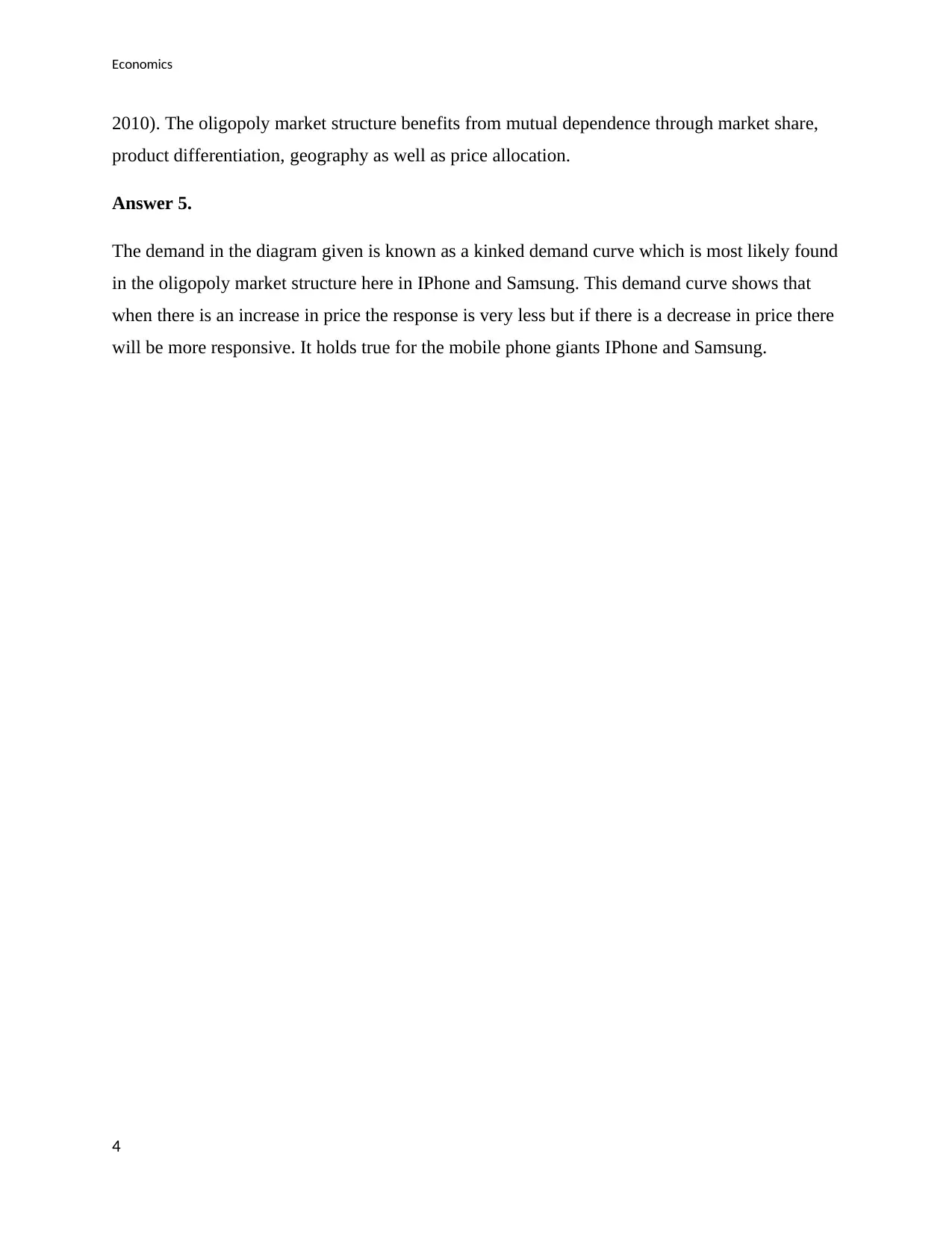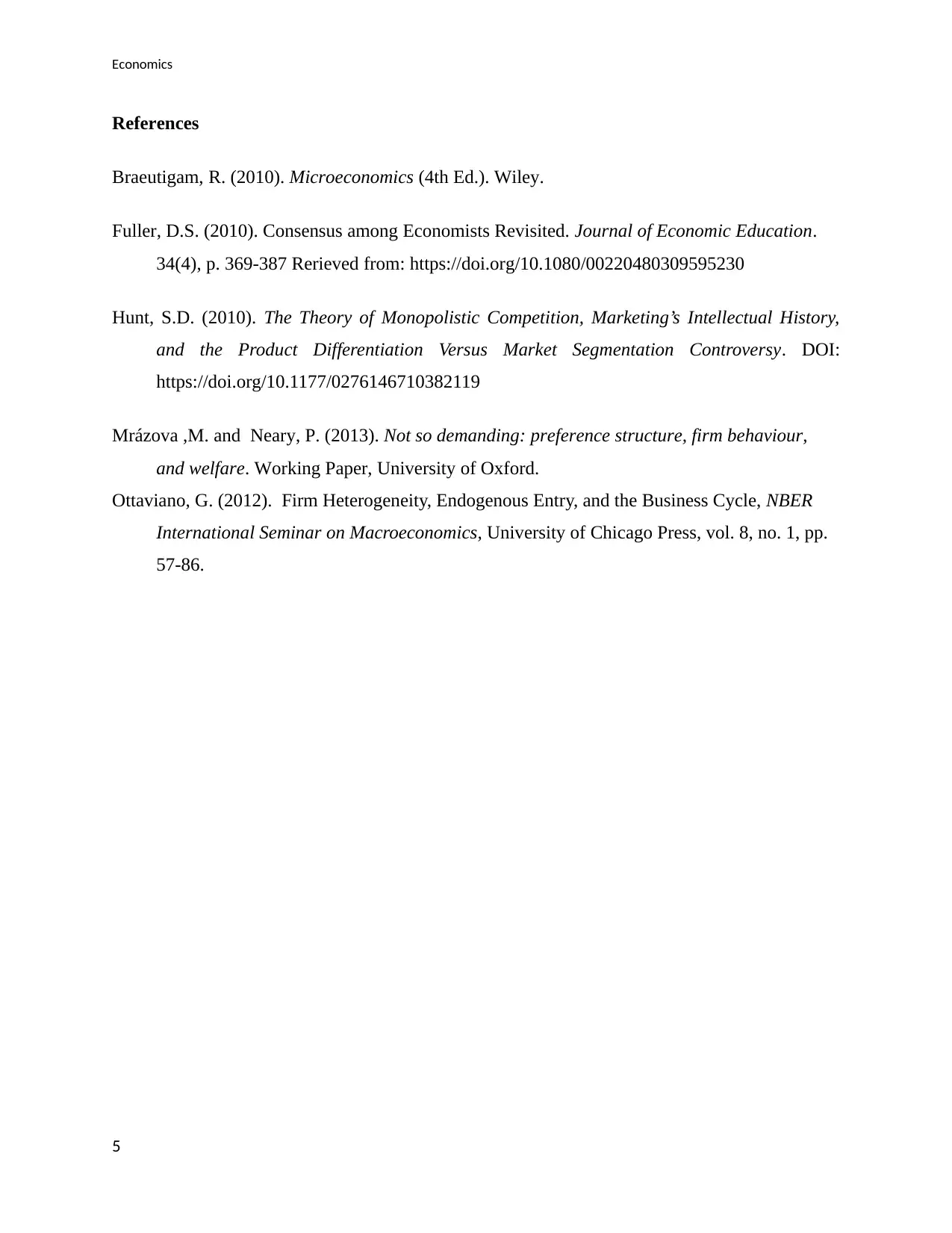MGE1108 Economics for Business Assignment - Semester 2, 2019
VerifiedAdded on 2022/12/12
|5
|1060
|391
Homework Assignment
AI Summary
This economics assignment explores various market structures including perfect competition, monopoly, monopolistic competition, and oligopoly. The solution compares these structures based on the number of firms, product similarity, and barriers to entry. It then classifies businesses like Aldi, tattoo parlors, and casinos into these market structures, providing justifications based on their characteristics. The assignment also examines non-price competition, mutual dependence, and the kinked demand curve, offering insights into strategies employed by firms. The document includes references to support the analysis and provide a comprehensive understanding of the concepts discussed.

Economics for business
Paraphrase This Document
Need a fresh take? Get an instant paraphrase of this document with our AI Paraphraser

Economics
Answer 1
a. The number of firms in a particular market structure is different from one another. In the case
of perfect competition and monopolistic competition, there are large numbers of independent
sellers whereas in an oligopoly market structure there are only a few numbers of independent
sellers. There is only one independent seller in case of a Monopoly market structure that has a
great influence on the market (Hunt, 2010).
b. There is a product differentiation for each market structure. In perfect competition, the
products that are sold are homogeneous whereas the product sold by a monopolistic competition
is close substitutes. A homogeneous product is nature is said to be the one that can be
distinguished from the competing supplier’s products. These products can be easily substituted
for another because they have the same physical characteristics and also the quality of these
products is similar to one another. The product sold by oligopoly may be either homogeneous or
close substitute. Monopoly is engaged in selling products that are a limited and remote substitute
(Hunt, 2010).
c. There is a very low barrier to entry in perfect competition or monopolistic competition market
structure. So, the entry in this type of market structure is quite easy and free. New players can
entry and exit the market. However, it is difficult for the new form to enter into an oligopoly
market as the entry is restricted. A Monopoly market structure has very high barriers to entry and
the new firms can't enter into the market (Hunt, 2010).
Answer 2.
(i) Aldi supermarket is a part of an oligopoly market structure because there are few
interdependent sellers and each can influence the market as a whole (Mrázova & Neary, 2013)
(ii) A tattoo parlor can be said to be an oligopoly market structure because the consumers are
very few and parlors are few. Each parlor can devise their own plan and play a dominant role in
increasing their reach (Mrázova & Neary, 2013)
(iii) Crown casino in Melbourne lies in an oligopoly market because there are only a few sellers
and each can plan their own strategy to grab the customers. Hence, no outlet is dependent on
each other.
2
Answer 1
a. The number of firms in a particular market structure is different from one another. In the case
of perfect competition and monopolistic competition, there are large numbers of independent
sellers whereas in an oligopoly market structure there are only a few numbers of independent
sellers. There is only one independent seller in case of a Monopoly market structure that has a
great influence on the market (Hunt, 2010).
b. There is a product differentiation for each market structure. In perfect competition, the
products that are sold are homogeneous whereas the product sold by a monopolistic competition
is close substitutes. A homogeneous product is nature is said to be the one that can be
distinguished from the competing supplier’s products. These products can be easily substituted
for another because they have the same physical characteristics and also the quality of these
products is similar to one another. The product sold by oligopoly may be either homogeneous or
close substitute. Monopoly is engaged in selling products that are a limited and remote substitute
(Hunt, 2010).
c. There is a very low barrier to entry in perfect competition or monopolistic competition market
structure. So, the entry in this type of market structure is quite easy and free. New players can
entry and exit the market. However, it is difficult for the new form to enter into an oligopoly
market as the entry is restricted. A Monopoly market structure has very high barriers to entry and
the new firms can't enter into the market (Hunt, 2010).
Answer 2.
(i) Aldi supermarket is a part of an oligopoly market structure because there are few
interdependent sellers and each can influence the market as a whole (Mrázova & Neary, 2013)
(ii) A tattoo parlor can be said to be an oligopoly market structure because the consumers are
very few and parlors are few. Each parlor can devise their own plan and play a dominant role in
increasing their reach (Mrázova & Neary, 2013)
(iii) Crown casino in Melbourne lies in an oligopoly market because there are only a few sellers
and each can plan their own strategy to grab the customers. Hence, no outlet is dependent on
each other.
2

Economics
(iv) Commonwealth Bank of Australia lies under the oligopoly market structure because there
are only a few banks that operate in the banking industry of Australia. The entry of new banks is
also difficult and restricted (Mrázova & Neary, 2013).
(v) A small store that has various similar stores in the city is a perfect competition market
structure because they are large in number and also the products that are sold by them are
homogeneous.
(vi) The small store that sells similar products is monopolistic competition because many sellers
are present and products are differentiated form one another
(vii) A café will come under monopolistic competition because there are many coffee shops that
provide services of food and coffee. Since sellers are few and sell coffee that differs in quality
hence monopolistic competition (Ottaviano, 2012)
(viii) iPhone and Samsung are in a monopolistic market structure because there are a large
number of sellers that are selling perfect substitutes and also the barriers to entry is low.
Answer 3.
a. Non-price competition is a type of competition in which there are two or more suppliers who
involve themselves in promotional expenditure. They do not try to manipulate the price of the
product to achieve their objective (Fuller, 2010). There is a change in the location and shape of
the demand curve in the case of non-price competition.
b. A firm that engages in the non-price competition will start spending money on promotional
activities such as location convenience, advertisement, special orders, gifts, coupons, etc. It will
try to carry out a research on the market and start with new product development to attract
customers. It will also try to understand the needs of the consumers and solve their grievances as
fast as possible to keep them satisfied (Fuller, 2010).
Answer 4.
Mutual dependence means collaboration between the sellers that are present in the market for
reducing the consumption of resources environment uncertainty is by adopting various strategies.
The market structure that experiences mutual dependence the most is an oligopoly (Braeutigam,
3
(iv) Commonwealth Bank of Australia lies under the oligopoly market structure because there
are only a few banks that operate in the banking industry of Australia. The entry of new banks is
also difficult and restricted (Mrázova & Neary, 2013).
(v) A small store that has various similar stores in the city is a perfect competition market
structure because they are large in number and also the products that are sold by them are
homogeneous.
(vi) The small store that sells similar products is monopolistic competition because many sellers
are present and products are differentiated form one another
(vii) A café will come under monopolistic competition because there are many coffee shops that
provide services of food and coffee. Since sellers are few and sell coffee that differs in quality
hence monopolistic competition (Ottaviano, 2012)
(viii) iPhone and Samsung are in a monopolistic market structure because there are a large
number of sellers that are selling perfect substitutes and also the barriers to entry is low.
Answer 3.
a. Non-price competition is a type of competition in which there are two or more suppliers who
involve themselves in promotional expenditure. They do not try to manipulate the price of the
product to achieve their objective (Fuller, 2010). There is a change in the location and shape of
the demand curve in the case of non-price competition.
b. A firm that engages in the non-price competition will start spending money on promotional
activities such as location convenience, advertisement, special orders, gifts, coupons, etc. It will
try to carry out a research on the market and start with new product development to attract
customers. It will also try to understand the needs of the consumers and solve their grievances as
fast as possible to keep them satisfied (Fuller, 2010).
Answer 4.
Mutual dependence means collaboration between the sellers that are present in the market for
reducing the consumption of resources environment uncertainty is by adopting various strategies.
The market structure that experiences mutual dependence the most is an oligopoly (Braeutigam,
3
⊘ This is a preview!⊘
Do you want full access?
Subscribe today to unlock all pages.

Trusted by 1+ million students worldwide

Economics
2010). The oligopoly market structure benefits from mutual dependence through market share,
product differentiation, geography as well as price allocation.
Answer 5.
The demand in the diagram given is known as a kinked demand curve which is most likely found
in the oligopoly market structure here in IPhone and Samsung. This demand curve shows that
when there is an increase in price the response is very less but if there is a decrease in price there
will be more responsive. It holds true for the mobile phone giants IPhone and Samsung.
4
2010). The oligopoly market structure benefits from mutual dependence through market share,
product differentiation, geography as well as price allocation.
Answer 5.
The demand in the diagram given is known as a kinked demand curve which is most likely found
in the oligopoly market structure here in IPhone and Samsung. This demand curve shows that
when there is an increase in price the response is very less but if there is a decrease in price there
will be more responsive. It holds true for the mobile phone giants IPhone and Samsung.
4
Paraphrase This Document
Need a fresh take? Get an instant paraphrase of this document with our AI Paraphraser

Economics
References
Braeutigam, R. (2010). Microeconomics (4th Ed.). Wiley.
Fuller, D.S. (2010). Consensus among Economists Revisited. Journal of Economic Education.
34(4), p. 369-387 Rerieved from: https://doi.org/10.1080/00220480309595230
Hunt, S.D. (2010). The Theory of Monopolistic Competition, Marketing’s Intellectual History,
and the Product Differentiation Versus Market Segmentation Controversy. DOI:
https://doi.org/10.1177/0276146710382119
Mrázova ,M. and Neary, P. (2013). Not so demanding: preference structure, firm behaviour,
and welfare. Working Paper, University of Oxford.
Ottaviano, G. (2012). Firm Heterogeneity, Endogenous Entry, and the Business Cycle, NBER
International Seminar on Macroeconomics, University of Chicago Press, vol. 8, no. 1, pp.
57-86.
5
References
Braeutigam, R. (2010). Microeconomics (4th Ed.). Wiley.
Fuller, D.S. (2010). Consensus among Economists Revisited. Journal of Economic Education.
34(4), p. 369-387 Rerieved from: https://doi.org/10.1080/00220480309595230
Hunt, S.D. (2010). The Theory of Monopolistic Competition, Marketing’s Intellectual History,
and the Product Differentiation Versus Market Segmentation Controversy. DOI:
https://doi.org/10.1177/0276146710382119
Mrázova ,M. and Neary, P. (2013). Not so demanding: preference structure, firm behaviour,
and welfare. Working Paper, University of Oxford.
Ottaviano, G. (2012). Firm Heterogeneity, Endogenous Entry, and the Business Cycle, NBER
International Seminar on Macroeconomics, University of Chicago Press, vol. 8, no. 1, pp.
57-86.
5
1 out of 5
Related Documents
Your All-in-One AI-Powered Toolkit for Academic Success.
+13062052269
info@desklib.com
Available 24*7 on WhatsApp / Email
![[object Object]](/_next/static/media/star-bottom.7253800d.svg)
Unlock your academic potential
Copyright © 2020–2025 A2Z Services. All Rights Reserved. Developed and managed by ZUCOL.





